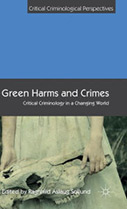Green Harms and Crimes: Critical Criminology in a Changing World

Editor: Ragnhild Aslaug Sollund
Publisher: Basingstoke, UK: Palgrave Macmillan, 2015. 302p.
Reviewer: Tanya Wyatt | September 2015
Green Harms and Crimes is the latest book in Palgrave’s Critical Criminological Perspective series edited by Professor Reece Walters and Dr Deborah Drake. It, as with the other books, fulfils the aim of the series to present critical aspects of current issues in criminology and wider society. This book has 13 chapters from both well-established critical scholars and new entrants to the discipline who have not yet completed their doctorates. This is one of the strengths of the book, as the established authors provide historical context whilst the early career scholars envision future horizons for the range of topics covered.
The editor, Ragnhild Sollund, sets the stage well in the introduction by detailing the role of critical criminology and how green (critical) criminology moves beyond this. She challenges the subfield to ask the questions others are not answering, such as what to do about human population growth. Sollund also eloquently defends green criminology’s research into animal abuse and wildlife crime, topics that come under criticism in one of the book’s chapters. Her own research in Chapter 8, as is usual for Sollund, provides robust qualitative research into Norway’s illegal wildlife trade that is grounded in anti-speciesism and an ecocentric perspective that sees the interconnectedness of all life.
The chapters are a collection from the conference of the European Group on the Study of Deviance and Social Control in 2014. Several of the authors devoted chapters to Stan Cohen, who had recently passed away, and as such grounded their investigations in his core contributions around genocide and denial. In Chapter 2, Avi Brisman and Nigel South point out that Cohen was not moved by environmental concerns, though the harm perpetrated against the environment is often by the actors (states and corporations and their nexus) on whom Cohen focused much of his research. They make a convincing case for the inclusion of green harm within critical criminology and for ecocide to become the fifth crime against peace, alongside genocide, and so using Cohen’s approach to human rights. Wayne Morrison continues the tribute to Stan Cohen in his chapter ‘Looking into the Abyss,’ where he also incorporates key contributions from two of criminology’s other greats who have recently been lost, Jock Young and Stuart Hall. In looking at the bloody independence war and current state of affairs in Bangladesh, Morrison joins other critical criminologists in challenging mainstream criminology to look at everyday life differently, and to look outside of the West for hidden atrocities and victims that demand and need attention.
Chapter 4, ‘A Critical Gaze on Environmental Victimization,’ by Lorenzo Natali puts forward a sophisticated rationale for expanding research into environmental victimology, as well as empirical methodologies which could be used in the future to uncover the range of green victims. For instance, he rightly highlights that we know very little about the lived experiences of environmental victims or their perceived risk of living in contaminated areas. Natali then proposes application of the potentially ‘transforming force’ of fraternite, whereby through the global ‘awareness of sharing a common condition of vulnerability’ this may move us towards protection of humans and non-humans alike.
In Vincenzo Ruggiero’s chapter ‘Creative Destruction and the Economy of Waste,’ an excellent argument is made that with global capitalism’s focus on growth and countries’ obsession with metrics like Gross Domestic Product as a measure of economic and social health, environmental crimes such as waste dumping and what he has called ‘dirty-collar crimes’ cannot be controlled either through regulation or legal sanctions. As Merton and Weber had proposed in various ways, the societal and economic pressure outweighs compliance. Ruggiero proposes that growth itself is criminogenic in degrading the environment as well as creating inequalities, which in turn causes relative deprivation – known to be correlated with crime. We must challenge growth and consumption in a multidisciplinary way.
Though agriculture is one of the main reasons for loss of biodiversity and deforestation, as of yet it is not often the topic of green research. That makes Allison Gray’s and Ron Hinch’s chapter ‘Agribusiness, Governments and Food Crime’ a welcome contribution to the field. They layout four topic areas to demonstrate the extent of food crime, which they broadly conceive of as including lack of safe working conditions and failure to provide healthy, safe food. The first of these is farm labour and low wages, and Gray and Hinch document the slave-like working conditions of cocoa farmers. Although this is an important concern for critical criminology, safe working conditions and labour rights seem to fit better within the field of health and safety crimes, where the corporate power dynamics have been scrutinized by a different set of scholars, and this portion of the chapter’s supporting research could include an additional robust literature base. The other areas highlighted – agribusiness farming techniques that degrade the land and create toxic hazards from animal waste, the mass use of pesticides and the corporate patenting of seeds – all contain critical analyses of the power of “agritech,” which has resulted in their interests being protected whilst the environment and farmers suffer.
Michael Lynch, Michael Long and Paul Stretesky rightly argue that human development is the main cause of species decline on the planet in their chapter ‘Anthropogenic Development Drives Species to be Endangered.’ Linking to their previous theorising on the treadmill of production and treadmill of crime, their chapter provides a welcome empirical addition demonstrating the relationship between human development and capitalism and threats to species survival. They do so by using the International Union for the Conservation of Nature’s Red List of endangered and threatened species as well as the United States Fish and Wildlife Service lists. Sadly though, the chapter is antagonistic and inaccurate in regards to previous research that it is unfairly and unnecessarily criticised. The chapter could have made its strong case for the need for further research into the connection between development and species extinction without belittling the existing research on wildlife crime, wildlife trafficking and poaching, and without in fairly stereotypical American fashion, devaluing qualitative methods such as case studies. Instead, they call for more studies into the structural nature of species harm rather than the focus on poaching, whilst failing to acknowledge that much of the existing literature points to the commodification and objectification (both structural) of other species as what drives their demise. This fits neatly within their own theory criticising capitalism. The use of the IUCN list to criticise what little impact poaching is having on species is limited in accuracy, as the Convention on the International Trade in Endangered Species (CITES) has the most accurate data as to what species are subjected to trade and overexploitation. Additionally, their chapter inaccurately asserts that wildlife crime and trafficking scholars do research in this area because it is a clear violation of the law, and so within mainstream criminology. This fails to capture the numerous critical studies in this area challenging speciesism and the hidden victimisation. Furthermore, existing scholarship related to species decline and poaching does not blame poor and indigenous people, nor does it claim poaching is the greatest threat – just one of many – to non-human animals and the environment. It is a shame such contributions are thought to ‘impede’ other research when they are in fact uncovering the structural systemic nature of non-human exploitation.
In ‘Denying the Harms of Animal Abductions for Biomedical Research’, Rodriguez Goyes brings to light a case probably little known in the West, where tens of thousands of owl monkeys were used to try to develop a malaria vaccine in Colombia. Not only advancing green criminology by furthering the understanding of animal abuse in the context of laboratory experimentation, he also makes an important contribution to critical criminology by expanding the geographic view and by challenging Western perspectives.
Joanna Hill in her chapter about systems thinking’s application to combat poaching demonstrates how diverse green criminology can be. By computer modelling of actors’ behaviours – rangers, poachers, wildlife – valuable information is gleaned that can then potentially be used to disrupt poacher activity and prevent wildlife crime. The combination of traditional criminological theory and computer modelling and technology is an innovative addition to the discussion around prevention and solutions.
Chapter 11 is Andrea Beckmann’s excellent critique of the mass media and society’s speciesist nature. ‘Now You See Me, Now You Don’t: About the Selective Permissiveness of Synoptic Exposure and Its Impact’ documents a provocative television advertisement by Animal Defenders International, showing a four-year old distressed child in a cage, and comparing him to a chimpanzee. The advertisement was not allowed on the air and Beckmann expertly unpicks why that is through application of Mathiesen’s ‘synopticon’ concept.
Samantha Fletcher’s ‘The Occupy Movement vs. Capitalist Realism’ chapter contains primary data from UK Occupy protestors that uncovers state responses to this movement. The responses range from brutal physical disruptions of the protest spaces, to criminalising the protestors in the media (claiming huge numbers of arrests when there were very few), to continual probing surveillance. Interestingly, Fletcher points out that though not acknowledged by the state, many of these responses were undertaken by private rather than public security. This raises many concerns in relation to power and accountability, as the chapter duly notes.
‘Refugee Protests and Political Agency’ by Katrin Kremmel and Brunilda Pali draws on Arendt, Butler and Ranciere to make the case that refugees are not subjects of humanitarian concern nor dangerous subjects, but are political subjects, which is demonstrated by their protesting in spite of their lack of the ‘right to have rights.’ They apply Butler’s idea of precarity – the differential distribution of precariousness – as a way forward for left politics. This has much in common with Natali’s proposal of fraternite.
Overall, each chapter makes a solid contribution to critical criminology in general by presenting old and new concepts in new ways and introducing new topics. My main criticism of the text is that Morrison’s, Fletcher’s, and Kremmel’s and Pali’s chapters do not fit within the title Green Harm and Crime, or in the overarching aim presented in the introduction to advance a green critical criminology. Whilst they are critical in their own right, it is a shame their contributions may get lost by being overlooked in this volume. The book is full of useful insights that will inform further research, and I look forward to the future research of all of the authors.
Tanya Wyatt, University of Northumbria


